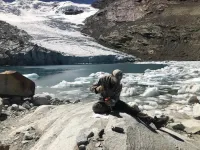(Press-News.org) Chestnut Hill, Mass (8/1/2024) – Rocks recently exposed to the sky after being covered with prehistoric ice show that tropical glaciers have shrunk to their smallest size in more than 11,700 years, revealing the tropics have already warmed past limits last seen earlier in the Holocene age, researchers from Boston College report today in the journal Science.
Scientists have predicted glaciers would melt, or retreat, as temperatures warm in the tropics – those regions bordering the Earth’s equator. But the study’s analysis of rock samples adjacent to four glaciers in the Andes Mountains shows that glacial retreat has happened far faster and already passed an alarming cross-epoch benchmark, said Boston College Associate Professor of Earth and Environmental Sciences Jeremy Shakun
“We have pretty strong evidence that these glaciers are smaller now than they have been any time in the past 11,000 years,” said Shakun, a paleoclimatologist and co-author of the report. “Given that modern glacier retreat is mostly due to rising temperatures – as opposed to less snowfall, or changes in cloud cover – our findings suggest the tropics have already warmed outside their Holocene range and into the Anthropocene.”
In other words, the glaciers may no longer be classified as being of the Holocene interglacial period, a significant epoch that saw the birth of civilization, where the flow of water and sea level dictated where towns and cities formed, and where agricultural and commercial activity emerged. Instead, they may be best classified by an epoch that may be well on its way to spelling their end: the Anthropocene.
The findings signal more of the world’s glaciers are likely retreating far faster than predicted, possibly decades ahead of a grim climatological schedule.
“This is the first large region of the planet where we have strong evidence that glaciers have crossed this important benchmark – it is a ‘canary in the coalmine’ for glaciers everywhere,” said Shakun.
Glaciers have been retreating worldwide over the past century but it has been unclear how the magnitude of this retreat compares to the range of natural fluctuations over the past several millennia, Shakun said. The team set out to determine how small tropical glaciers are today compared to their range over the last 11,000 years.
Researchers who formed the international team of scientists traveled to Colombia, Peru, and Bolivia to measure the chemistry of bedrock only recently uncovered in front of four melting glaciers spanning the tropical Andes. Two rare isotopes – beryllium-10 and carbon-14 – build up in bedrock surfaces when they are exposed to cosmic radiation from outer space, Shakun said.
“By measuring the concentrations of these isotopes in the recently exposed bedrock we can determine how much time in the past the bedrock was exposed, which tells us how often the glaciers were smaller than today – kind of like how a sunburn can tell you how long someone was out in the sun,” Shakun said.
Shakun led the project with former BC graduate student Andrew Gorin, partnering with researchers from the University of Wisconsin and Tulane University on the American Cordillera project, then seeking samples and data from colleagues at Aix-Marseille University, the National University of Ireland, Aspen Global Change Institute, Ohio State University, Union College, University Grenoble Alpes, and Purdue University.
“We found essentially no beryllium-10 or radiocarbon-14 in any of the 18 bedrock samples we measured in front of four tropical glaciers,” said Gorin, now a PhD student at UC-Berkeley. “That tells us there was never any significant prior exposure to cosmic radiation since these glaciers formed during the last ice age.”
Twenty years ago, researchers at the Quelccaya Ice Cap in Peru, the largest tropical ice mass in the world, found rooted plant remains melting out of the ice margin as it retreated. Radiocarbon dating showed that those plants were 5,000 years old, indicating Quelccaya had been larger than its size at the time of that study for that whole interval— otherwise the plants would have decayed away if there was a prior period of exposure, Shakun said.
Those Quelccaya findings suggested that modern ice retreat has been abnormally large, but was not yet progressing to an alarming level compared to ice melt across the entire Holocene, Shakun said. He and his team wanted to study a larger number of glaciers and use a technique that can unambiguously show if a glacier was ever smaller than today.
Shakun and his colleagues have been applying the same technique to glaciers along the entire length of the American Cordillera, from Alaska to Tierra del Fuego. The team previously published the results of its North American sampling last year and aims to publish the results from southern South America soon.
“Once we do that, then these studies can all be put together into a global perspective on the current state of glacier retreat,” said Shakun.
END
Andean glaciers have retreated to lowest levels in 11,700 years, news study finds
No longer covered in ice, Andean rocks signal the world’s glaciers are melting far faster than predicted, reports an international team of scientists led by Boston College researchers
2024-08-01
ELSE PRESS RELEASES FROM THIS DATE:
States consider new science-backed solution to save time and money on concrete infrastructure repair
2024-08-01
WEST LAFAYETTE, Ind. — A Purdue University invention that may shorten construction timelines and increase long-term durability of concrete highways, bridges and other transportation infrastructure is emerging as a viable alternative to methods that have been used for decades to estimate when newly poured concrete is mature enough to withstand heavy loads such as those from trucks and other vehicles.
The American Association of State Highway and Transportation Officials’ Committee on Materials and Pavements (AASHTO COMP) has approved the Purdue-developed method as a new national ...
New England Journal of Medicine letter shows plant protein beats animal protein
2024-08-01
BOSTON—Plant-based proteins have major health advantages over animal-based proteins, according to a New England Journal of Medicine letter to the editor by Neal D. Barnard, MD, published Aug. 1, 2024. New findings show that all plants contain all essential amino acids, in contrast to the common but mistaken belief that plants lack one or more amino acids. Of the 20 amino acids that are the building blocks of protein, nine cannot be produced by the human body. All are found in plant sources.
“In addition, plant-based ...
August issues of APA journals cover new research on PTSD, suicide, personal recovery, eating disorders, and more
2024-08-01
WASHINGTON, D.C., Aug. 1, 2024 — The latest issues of three American Psychiatric Association journals, The American Journal of Psychiatry, Psychiatric Services, and Focus are now available online.
The August issue of The American Journal of Psychiatry brings together research on PTSD, phobias, suicide attempts, and psychiatric vulnerabilities. Highlights include:
Neurobiology and Treatment of Posttraumatic Stress Disorder.
Testing Quantitative and Qualitative Sex Effects in a National Swedish Twin-Sibling Study of Posttraumatic Stress Disorder.
Sexual Identity Continuity and Change in a U.S. National Probability Sample of Sexual Minority Adults: Associations ...
Angel Martí elected fellow of the American Chemical Society
2024-08-01
By Jade Boyd
Special to Rice News
Rice University’s Angel Martí has been elected a fellow of the American Chemical Society (ACS), one of his discipline’s highest honors.
Martí, professor and department chair of chemistry, is among 37 newly elected fellows announced by ACS this week. With more than 200,000 members in 140 countries, ACS is one of the largest scientific organizations. Fewer than 1% of its members are fellows, a distinction reserved for those with exemplary records of both service to the society and outstanding scientific or professional achievement.
Martí joined ...
Rice, DOE labs tackle knowledge gap in materials science research
2024-08-01
HOUSTON – (August 1, 2024) – Materials behave differently in different size regimes, and researchers tend to cluster their efforts either at the nanoscale, examining materials in atom-level detail, or at the microscale, looking at structures between three and five orders of magnitude greater.
However, less is known about what happens in the “in-between” realm spanning from 10 billionths to 1 millionth of a meter.
“We call this the mesoscale,” said Rice University materials scientist Lane Martin, who together with collaborators at the U.S. Department of Energy’s (DOE) Argonne National Laboratory and Lawrence Berkeley National ...
ACM publishes first issue of Proceedings of the ACM on Software Engineering
2024-08-01
ACM, the Association for Computing Machinery, has recently published the first issue of Proceedings of the ACM on Software Engineering (PACSME), a new Gold Open Access journal publishing top-quality, original research on all aspects of software engineering, from requirements elicitation to quality assessment, design, maintenance, evolution, and deployment. PACMSE covers a broad range of topics and methods that help conceive, create, and maintain better software be it embedded, cloud-based, mobile and ubiquitous, or runs on conventional computers.
“The overarching goal of the new PACSME journal is to make ...
Barriers complicate exercise for disability community
2024-08-01
An estimated 16% of people worldwide live with a significant disability that impacts their daily life. Of this population, only about 40% engage in aerobic activity. Due to this lack of exercise, people with disabilities (PWD) are more likely to suffer from chronic conditions such as heart disease, stroke, diabetes, or cancer and are at higher risk of mental illnesses like depression and anxiety.
“Many PWD struggle with psychological issues such as low self-esteem and negative body image, which can further reduce their motivation to participate in exercise activities, especially in public places ...
Venezuelan crisis has negatively affected country’s Internet
2024-08-01
As the Venezuelan crisis intensifies, researchers and policy experts have worked to understand its ramifications on the country’s politics, economics, health services, water security, infrastructure and more.
Now, Northwestern University computer scientists have comprehensively examined the effects of the crisis on a previously unexplored area: the Internet.
In a new study, the researchers found the crisis has significantly — and negatively — affected Venezuela’s Internet infrastructure and connectivity. Compared to the ...
COSPAR 2024: Embracing team spirit in space research
2024-08-01
The Committee on Space Research (COSPAR) has successfully concluded its 45th COSPAR Scientific Assembly in Busan, Korea, held from 13 to 21 July. This prestigious event brought together more than 3,000 experts and leaders from 55 countries in all major fields of space science, under the theme “Team Spirit in Space Research”. This biennial event, actively supported by major space organizations, is a benchmark for fostering dialogue and collaboration within the global space science community.
Bringing space leaders together
Of particular note this time was the showcasing of ...
'Cowpuppy' takes readers into secret world of cows
2024-08-01
During the height of the COVID-19 pandemic Gregory Berns, a neuroscientist at Emory University, moved from Atlanta to a farm an hour south of the city. His reinvention from city dweller to farmer led to his upcoming book “Cowpuppy: An Unexpected friendship and a Scientist’s Journey into the Secret World of Cows.”
Set for publication by Harper Collins on August 20, the book describes Berns’ crash course to becoming a cattleman and his ongoing fascination with the interior world of cows.
Berns originally bought a few cows to keep the grass in the ...
LAST 30 PRESS RELEASES:
Ticking time bomb: Some farmers report as many as 70 tick encounters over a 6-month period
Turning garden and crop waste into plastics
Scientists discover ‘platypus galaxies’ in the early universe
Seeing thyroid cancer in a new light: when AI meets label-free imaging in the operating room
Neutrophil-to-lymphocyte ratio may aid risk stratification in depressive disorder
2026 Seismological Society of America Annual Meeting
AI-powered ECG analysis offers promising path for early detection of chronic obstructive pulmonary disease, says Mount Sinai researchers
GIMM uncovers flaws in lab-grown heart cells and paves the way for improved treatments
Cracking the evolutionary code of sleep
Medications could help the aging brain cope with surgery, memory impairment
Back pain linked to worse sleep years later in men over 65, according to study
CDC urges ‘shared decision-making’ on some childhood vaccines; many unclear about what that means
New research finds that an ‘equal treatment’ approach to economic opportunity advertising can backfire
Researchers create shape-shifting, self-navigating microparticles
Science army mobilizes to map US soil microbiome
Researchers develop new tools to turn grain crops into biosensors
Do supervised consumption sites bring increased crime? Study suggests that’s a myth
New mass spec innovation could transform research
Maternal nativity, race, and ethnicity and infant mortality in the US
Migration-related trauma among asylum seekers exposed to the migrant protection protocols
Jupiter’s moon Europa has a seafloor that may be quiet and lifeless
SwRI upgrades nuclear magnetic resonance laboratory for pharmaceutical R&D
House sparrows in northern Norway can help us save other endangered animals
Crohn's & Colitis Foundation survey reveals more than 1/3 of young adults with IBD face step therapy insurance barriers
Tethered UAV autonomous knotting on environmental structures for transport
Decentralized social media platforms unlock authentic consumer feedback
American Pediatric Society announces Vanderbilt University School of Medicine as host institution for APS Howland Visiting Professor Program
Scientists discover first method to safely back up quantum information
A role for orange pigments in birds and human redheads
Pathways to net-zero greenhouse gas emissions for Southeast Asia
[Press-News.org] Andean glaciers have retreated to lowest levels in 11,700 years, news study findsNo longer covered in ice, Andean rocks signal the world’s glaciers are melting far faster than predicted, reports an international team of scientists led by Boston College researchers







